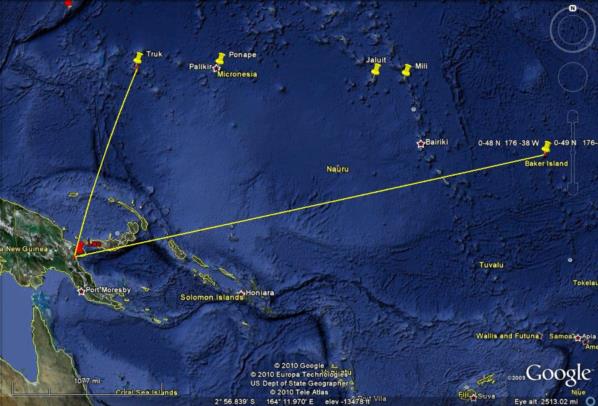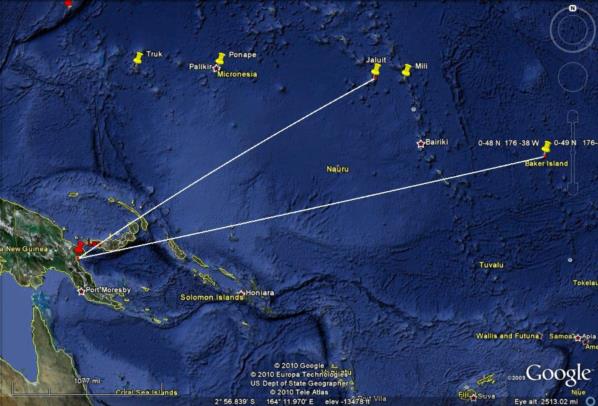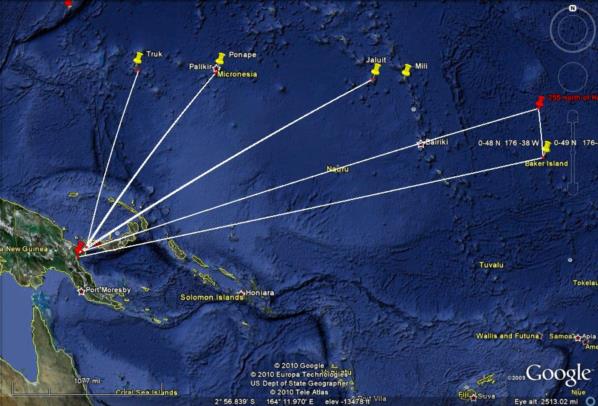
NavList:
A Community Devoted to the Preservation and Practice of Celestial Navigation and Other Methods of Traditional Wayfinding
Was Earhart a Spy, Second spy theory
From: Gary LaPook
Date: 2010 May 24, 14:29 -0700
From: Gary LaPook
Date: 2010 May 24, 14:29 -0700
I wrote before: "There have been many who have claimed that Earhart was on a spy mission when she disappeared and have raised Earhart’s role in gathering intelligence about Japan’s actions in the Mandated Islands. (I do wonder however if any these theories were advanced prior to the 1943 Rosalind Russell movie, Flight For Freedom, which had that story line.) I decided to look at this from a piloting and aircraft performance point of view. It turns out that there are actually two different theories. One, that she was a spy herself, flying over the Japanese held Islands and taking pictures of their installations with cameras hidden in her airplane. A second theory is that she was not taking pictures herself but that she would stage a disappearance to give the U.S. Navy the excuse to search the Mandated Islands so that the Navy could take pictures of Japanese installations. We need to look at these two different theories separately. " -------------------------------------------------------------------------------------------------------------------------------------- Now lets look at the second theory, that she was to stage her own disappearance to give the U.S. Navy a justification to search throughout the Japanese Mandated Islands. Let's see if this would have worked by looking at it from the flight navigation point of view. The distance from Lae to Howland is 2556 statute miles and the course is 078 degrees true (image 6.) ( I state all courses in relationship to true north instead of magnetic north, true directions, not magnetic directions and distances are in statute miles.) Images 12, 13 & 14 show the courses to Truk, Ponape and Jaluit. (I am not considering Palau since it is so far off course.) The course to Truk is 18 degrees meaning the plane would have to be 60 degrees off course to get to the vicinity of that island. The course to Ponape is 38 degrees, off course by 40 degrees. To Jaluit is 60 degrees, 18 degrees off course. Another way to look at this is to see how many miles off course they would be if they were in the vicinity of those islands. Image 15 shows the perpendicular distances from the course to Howland to the various islands. Truk is 910 miles off course, Ponape is 770 and Jaluit is 580. The commonly accepted level of uncertainty of in-flight dead reckoning is 10% of the distance flown. So even without a navigator on board and with Earhart doing her own dead reckoning navigation, just holding a heading based on correcting for the forecast winds, and with no fixes in flight, no celestial fixes and no visual fixes over an island, she should not have been off course more than 255.6 SM either to the north or to the south of Howland. Image 16 illustrates the area she might have been expected to overfly on her way to Howland if using just dead reckoning. It extends 255 miles north of Howland which is about 6 degrees off the course to Howland. (A like area would be south of course but that is not important to this discussion.) Even though the area of course uncertainty extends 6 degrees either side of course, you are more likely to be closer to the course line than to the edges of the area. The probability drops off gradually as you move further away from the course line. With a navigator on board, obtaining celestial fixes fairly regularly, the plane should be very close to the course line and it is unlikely that it was ever near the edge of the area of course uncertainty. Image 17 shows how far off course in excess of the area of course uncertainty it would be to go to the islands. Since the course uncertainty is 6 degrees these numbers are six degrees less than the previous numbers, 54 degrees to Truk, 34 to Ponape and 12 to Jaluit. The 10% area of uncertainty expands in the along course dimension too. Even though the airplane (using dead reckoning) may have flown through the course uncertainty area it is not going to be near the western end of it since they flew through that area many hours prior to the last transmission. The plane is not likely to be more than 255 miles short of Howland nor likely to be more than 255 miles past Howland. Image 18 shows the final area of uncertainty (with the area south of the course line omitted. It would be the same size as the area north of the course line.) Like the uncertainty in the course, the plane is more likely to be near the center than near any of the edges. Again, with a navigator on board, the uncertainty would be much less. Image 19 shows the line from Jaluit to the nearest corner of the final area of uncertainty. This distance is 670 SM. It is slightly less to Mili, 530 miles. It is 1460 to Ponape and 1880 to Truk. The Japanese also understood navigation. It would be very difficult to convince them of a legitimate need to search near Truk, 1880 miles from the outer limits of her likely position or even to search near Mili, fully 530 miles away. To put this into perspective, image 20 shows an analogous situation projected onto the U.S. If I were to disappear while flying my plane from Los Angeles to New York my family would have a very hard time convincing the police chief of New Orleans to make a search for my plane in the swamps nearby. New Orleans is 780 miles off course, about the same as Ponape. Since the U.S. planners would have been aware that they would not be able to pull the wool over the eyes of the Japanese, there is no reason to believe that they would have attempted this deception. gl





-search-area.jpg.thumb.jpg)










